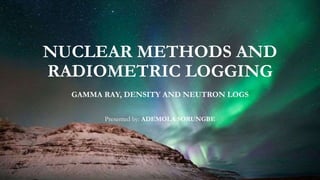This document discusses nuclear logging methods, including gamma ray, density, and neutron logs. It provides background on how these tools work and what formation properties they measure. Gamma ray logs measure natural radioactivity to identify lithology and correlate between wells. Density logs measure bulk density and are used to estimate porosity and identify fluid types. Neutron logs measure hydrogen content to also determine porosity and fluids. The document explains the operating principles, responses, and applications of each nuclear log.























































